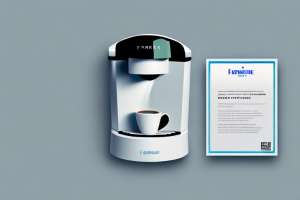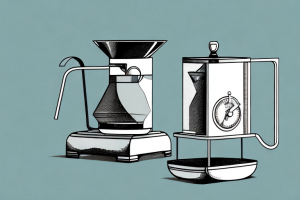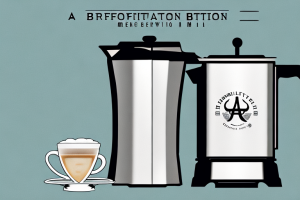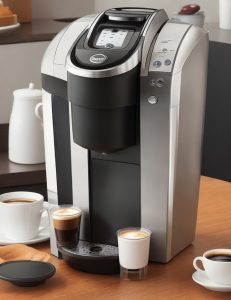Baking Soda To Clean Coffee Maker

A coffee maker being cleaned with baking soda
Are you tired of drinking coffee that tastes stale, or worse, like it’s been sitting around for days on end? If so, you may need to clean your coffee maker using baking soda. This common household item isn’t just great at deodorizing your fridge or removing stains from your clothes – it can also work wonders on your coffee maker. In this article, we’ll explore the benefits of using baking soda to clean your coffee maker, how it works, and provide step-by-step instructions for cleaning your coffee maker using this inexpensive and natural cleaner.
Why Use Baking Soda To Clean Your Coffee Maker
While there are certainly a variety of cleaners available on the market that promise to get your coffee maker squeaky clean, many of them contain harsh chemicals that can be harmful to your health or even damage your machine. Baking soda, on the other hand, is a natural and safe alternative that won’t leave any harmful residue behind. It’s also incredibly effective at removing stains and buildup from your machine without causing any damage or scratches.
In addition to being safe and effective, using baking soda to clean your coffee maker is also incredibly affordable. A small box of baking soda can be purchased for just a few dollars and can be used for multiple cleanings. This makes it a great option for those who want to save money on cleaning products.
Another benefit of using baking soda to clean your coffee maker is that it’s environmentally friendly. Many commercial cleaners come in plastic bottles that end up in landfills, but baking soda can be purchased in cardboard boxes that are easily recyclable. Plus, since baking soda is a natural substance, it won’t harm the environment when it’s washed down the drain.
The Benefits Of Using Baking Soda To Clean Your Coffee Maker
Beyond its natural and safe qualities, using baking soda to clean your coffee maker has a variety of benefits. For one, it’s incredibly affordable – a small box can last you many cleanings. It’s also eco-friendly and won’t harm the environment. Plus, it can help extend the life of your machine, as regularly cleaning it will prevent buildup and other issues from occurring. Lastly, it removes not just stains and buildup, but also any lingering odors that may be affecting the taste of your coffee.
Another benefit of using baking soda to clean your coffee maker is that it’s a natural and non-toxic alternative to harsh chemical cleaners. This means that you won’t have to worry about any harmful chemicals coming into contact with your coffee or affecting your health. Additionally, baking soda is a gentle abrasive, which means that it can effectively remove stubborn stains and buildup without scratching or damaging the surface of your coffee maker. Overall, using baking soda to clean your coffee maker is a safe, affordable, and effective way to keep your machine in top condition and ensure that your coffee always tastes great.
How Does Baking Soda Work To Clean Coffee Makers
Baking soda is an alkaline substance, which means it works to neutralize acids that may be present in your coffee maker. These acids can cause staining and discoloration, but baking soda can lift them easily and effectively. Additionally, baking soda has abrasive qualities, which allows it to scrub away any buildup or stains that may have accumulated over time. When combined with water, it creates a paste that can easily be spread throughout your machine, getting into the hard-to-reach places and leaving your coffee maker looking like new.
Another benefit of using baking soda to clean your coffee maker is that it is a natural and non-toxic alternative to harsh chemical cleaners. This means that you can clean your coffee maker without worrying about any harmful chemicals being left behind that could potentially contaminate your coffee. Baking soda is also an affordable and readily available cleaning solution that can be found in most households.
It is important to note that while baking soda is effective at cleaning coffee makers, it should not be used on aluminum coffee makers as it can cause discoloration. Additionally, it is recommended to rinse your coffee maker thoroughly after cleaning with baking soda to ensure that no residue is left behind that could affect the taste of your coffee.
Step-by-Step Guide: Cleaning Your Coffee Maker With Baking Soda
Now that you understand the benefits and working mechanism of baking soda in cleaning coffee makers, it’s time to get into the nitty-gritty: how to actually use baking soda to clean your machine.
- First, remove any leftover coffee or filters from your machine.
- Then, mix ¼ cup of baking soda with 1 cup of warm water.
- Pour this solution into your coffee maker’s water chamber and turn it on, allowing the mixture to run through the machine.
- Once the cycle is complete, turn off the machine and let it sit for 15-20 minutes to allow the baking soda to continue working its magic.
- Next, pour out the solution and refill the chamber with cold water, running another cycle to rinse the machine thoroughly.
- Repeat this rinse cycle until the water runs clear.
- Lastly, wipe down the outside of your coffee maker with a damp cloth, and voila! Your machine is now clean and ready to brew delicious, fresh coffee.
It’s important to note that cleaning your coffee maker with baking soda should be done regularly to prevent the buildup of mineral deposits and bacteria. Experts recommend cleaning your machine at least once a month, or more frequently if you use it daily. Additionally, if you notice any strange odors or tastes in your coffee, it may be a sign that your machine needs a deep clean with baking soda.
How Often Should You Clean Your Coffee Maker With Baking Soda?
Now that you know how to clean your coffee maker with baking soda, you’re probably wondering how often you should do so. Experts recommend cleaning your machine every 40-80 brew cycles, depending on how frequently you use it. For most people, this means cleaning your coffee maker about once a month.
However, if you use your coffee maker more frequently, you may need to clean it more often. For example, if you make coffee every day, you may want to clean your machine every two weeks. On the other hand, if you only use your coffee maker occasionally, you may be able to get away with cleaning it every two to three months.
It’s also important to note that if you notice any buildup or residue in your coffee maker, you should clean it right away. This can help prevent any potential health hazards and ensure that your coffee tastes as good as possible. So, while it’s important to clean your coffee maker regularly, don’t hesitate to do so more often if needed.
Other Uses of Baking Soda in Cleaning Kitchen Appliances
Beyond coffee makers, baking soda can also be used in cleaning other kitchen appliances. For example, it’s great for removing stains and buildup from your toaster, microwave, or even your refrigerator. Simply mix with water to create a paste and use a soft cloth to scrub away any grime or dirt. It’s an easy and effective solution for maintaining a clean and odor-free kitchen.
In addition to cleaning kitchen appliances, baking soda can also be used to freshen up your kitchen. Simply place an open box of baking soda in your pantry or refrigerator to absorb any unwanted odors. You can also sprinkle baking soda on your cutting board to remove any lingering smells from garlic or onions.
Another great use for baking soda in the kitchen is as a natural pesticide. Mix equal parts baking soda and salt and sprinkle it around areas where you see ants or other pests. The baking soda will disrupt their pheromone trails and deter them from coming back.
How to Maintain Your Coffee Maker After Cleaning it with Baking Soda
After cleaning your coffee maker with baking soda, you’ll want to take a few steps to ensure that it stays clean and in good working condition. This includes regularly removing leftover coffee and filters, wiping it down with a damp cloth, and not using harsh chemicals or abrasive materials to clean the machine. By taking care of your coffee maker, you’ll be able to enjoy fresh and delicious coffee for years to come.
Another important step in maintaining your coffee maker is to descale it regularly. Over time, mineral deposits from the water can build up inside the machine, affecting the taste of your coffee and even causing damage to the machine. To descale your coffee maker, mix equal parts water and white vinegar and run it through the machine. Then, run a few cycles of plain water to rinse out any remaining vinegar. This should be done every 3-6 months, depending on how often you use your coffee maker and the hardness of your water.
DIY Cleaning Solutions for Coffee Makers Using Baking Soda and Other Household Products
While baking soda is a great cleaning solution for coffee makers, it can be even more effective when combined with other household products. For example, adding a bit of vinegar or lemon juice can help remove stubborn stains and buildup. There are many DIY recipes available online, so feel free to experiment and find what works best for you.
In addition to baking soda, vinegar, and lemon juice, there are other household products that can be used to clean coffee makers. For instance, citric acid is a natural cleaner that can effectively remove mineral buildup in coffee makers. Another option is using hydrogen peroxide, which can help disinfect and remove stains.
It’s important to note that when using DIY cleaning solutions for coffee makers, it’s crucial to thoroughly rinse the machine with water afterwards to avoid any residual taste or smell. Additionally, it’s recommended to clean your coffee maker at least once a month to ensure it’s functioning properly and producing the best tasting coffee possible.
Common Mistakes to Avoid When Cleaning Your Coffee Maker with Baking Soda
While baking soda is a safe and effective cleaning solution, there are a few common mistakes to avoid in order to get the best results. One mistake is using too much baking soda, as this can cause clogs in your machine or leave behind a residue. Another mistake is not rinsing your coffee maker enough to remove all the baking soda – this can lead to a gritty or unpleasant taste in your coffee. By following the instructions carefully and using the correct amount of baking soda, you’ll be able to avoid these mistakes and enjoy a perfectly cleaned coffee maker.
In conclusion, using baking soda to clean your coffee maker is an affordable, natural, and effective solution for keeping your machine in top condition. By following the simple steps outlined in this article, you’ll be able to remove stains, buildup, and odors that can affect the taste of your coffee, all while extending the life of your machine. So next time your coffee tastes off, don’t reach for a new bag of beans – try cleaning your coffee maker with baking soda instead!
It’s important to note that while baking soda is a great cleaning solution for most coffee makers, it may not be suitable for all types. For example, if you have a coffee maker with a stainless steel or aluminum interior, using baking soda may cause discoloration or damage to the surface. In these cases, it’s best to consult the manufacturer’s instructions or use a specialized cleaning solution. Additionally, if you have a coffee maker with a built-in grinder, it’s important to clean the grinder separately and not use baking soda on it, as this can damage the blades and affect the quality of your coffee.



